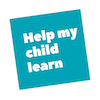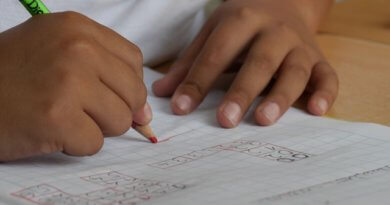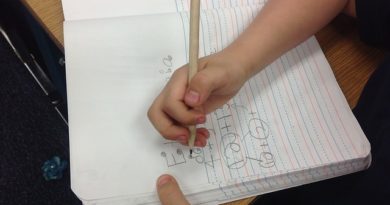Handwriting and Focus: From Form Drawing to Handwriting Therapy
Many of children with handwriting problems actually have problems with the foundations of learning: their brains aren’t mature enough to have developed the proprioceptive sense, and their fine motor skills are underdeveloped.
Proprioception, described in this post about Proprioception, is something that parents never think about unless something is wrong, but it really matters.
What has to happen before a child can write?
It takes brain-body development for the brain to know where the hands are, and it takes more development for the brain to control the hands with fine motor skills.
In order to write, a child needs to visualize letters, keep the picture of letters in their brain while they decide what to write (using their working memory), and then remember how to make the letters with their hands. If the child has problems connecting ideas with physical actions, this can be very difficult.
In order to make writing legible, children need to physically understand how much space goes between letters, and create that amount of space with their fine motor skills. They also need to make sure that they follow the line, making letters straight.
There is an entire world of brain-body development that goes on in learning to write.
Actually, Drilling Physical Skills Isn’t a Bad Idea!
A teacher, now retired, once told me that when she was a child, they used to practice handwriting for an hour every day. Not only does that type of practice help cement handedness and improve handwriting—it also improves emotional stability. Here are some notes about why learning cursive is a valuable skill.
American schools don’t sit children down and drill them with handwriting for hours any more. Handwriting is a bit similar to typing. Instead of (boring) typing drills, we buy little typing games for children, and we try to get our children to play the games.
It’s hard to get our children to do things that aren’t fun.
And we all know that
Practicing handwriting is no fun.
It’s boring.
Form Drawing
It’s a rule of the brain that, if the brain is not engaged, it’s not paying attention. The Waldorf form drawing program introduces many different symbols that require the same sorts of skills as handwriting. But if your child is resisting practicing or learning regular homework, the Form Drawing program is fun and engaging. The form drawing program also helps children develop pre-writing skills. If your child’s foundational skills are immature, form drawing can help.
Creative form drawing helps children develop hand-eye coordination, spatial orientation, observation skills, attention, confident movement, drawing skills, and foundational skills for handwriting. This book, by Angela Lord, contains instructions for teachers, parents, and homeschooling parents.
Here’s a video from a homeschooling mother talking about what’s in this book.
At the very beginning, students start by drawing a straight line and a curved line. But that lesson is in first grade. If your child is in a higher grade, you can go through the book and select other forms to draw.
We talk a lot about multisensory reading, but multisensory writing practice is very effective as well. Students are taught that the hand movements are similar to entire body movements. The book also encourages students to make the designs with their entire body, or with their nose. This type of exercise helps to develop visualization, and a strong connection between the brain and body.
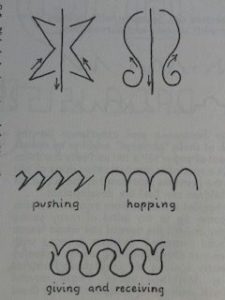
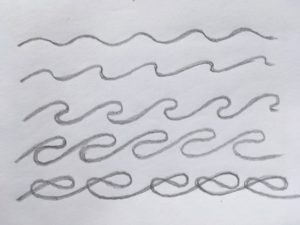
The book is beautiful, filled with colors, and the exercises teach students how to look, feel, control the movement of their pencils, be conscious of spacing, and so forth.
Here’s the same Homeschooling mom in Pepper and Pine’s video page, showing an entire group of form drawing lessons, and how she did them
Yes, much of the form drawing is for younger children, but older children can breeze through it, and they can enjoy making beautiful designs while making their foundational skills stronger. After all, many adults now color. Why not everyone?
If your child is frustrated, has terrible handwriting, and you’re looking for something to try, we highly suggest this. If you try it, comment and tell us how it goes!
Handwriting Therapies
The Integrated Learning Systems people have a great approach to dysgraphia. Note: dysgraphia can be either similar to dyslexia, or it can be physical. In this post we’re talking about the writing-specific challenges.
As part of their approach, ILS have created a writing workbook, filled with all sorts of writing exercises that your child can use.
Another therapy is Jeanette Farmer’s Retrain the Brain. Farmer is one of the top handwriting experts in the country, and her class explains how handwriting class can help with everything from handedness, to emotional control.
Sensory-based Handwriting Learning
Here’s a great description of a sensory-based handwriting class. Using multisensory techniques, like drawing in rice, to help children remember letters, this class description is full of great ideas you can use at home.
Take away: The best practice for handwriting is multisensory — and repetitive. Repetitive drills won’t kill today’s kids. On the contrary, it’s a great way to move control of the brain to the left side of the brain, and exercise fine motor skills.
